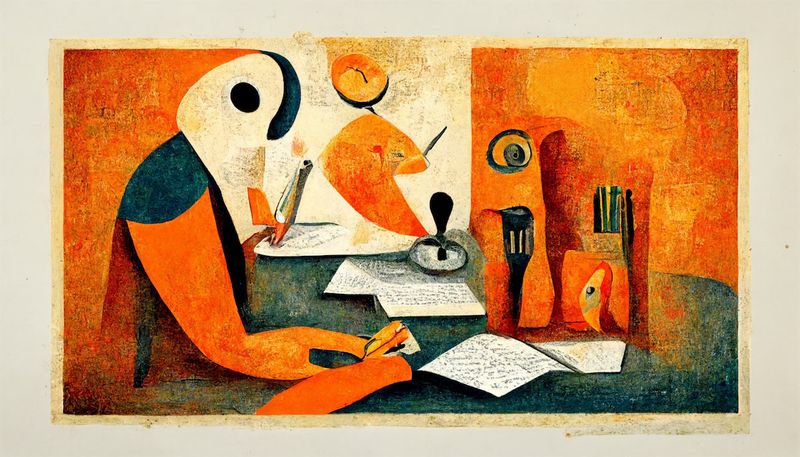"To make something great, just re-do it, re-do it, re-do it."
– Kevin Kelly
Great writing often starts off as average writing.
It becomes great through a diligent editing process.
Learning to edit both your work and that of your peers is an invaluable step to becoming the writer you want to be. Thankfully, most writers can become good editors by following a few basic principles.
In this short guide, we lay out 8 ways you can up your editing game.
1. Shift into an editor's mindset.
Being an editor is not the same as being a critic.
As an editor, you have to identify what doesn’t work and make constructive suggestions on how to move a piece forward.
Ultimately, an editor and a writer are partners. You don’t need to agree with everything the writer says, but you should at least understand what they are trying to say.
When editing a draft, point out what you find concerning or significant. Push the other person to explain their thinking. Ask clarifying questions, request sources for their references, and push them to provide examples that support their ideas.
Writing is a very personal, vulnerable process. You’re on the writer’s team and want to support their goals while productively challenging them on the things you don’t think are helping.
Live somewhere in the middle.
2. Clarify the writer’s objective.
It will be nearly impossible to give useful feedback without understanding what a writer is trying to say.
Before you start giving feedback, clarify the writer’s objective. Skim the first few paragraphs, glance over the structure of the piece, and see if you can grasp the key idea or ideas.
Ask yourself, what’s the core idea this draft is trying to convey?
Secondly, focus on the type of feedback the writer is looking for. Oftentimes, the writer already has an intuition about where their draft needs help and they’ll provide editing guidelines.
If the writer specifically says they don’t want copy edits, then don’t correct every small grammatical error.
3. Consider structure.
Once you’re clear on what a writer is trying to communicate, ask yourself if the draft follows a sensible structure.
Have they laid out the story or argument in a coherent way?
While there is no single “right” way to structure a piece, the reader should be left with some basic sense of coherence and order.
Here are a few practical tips:
- Try to reverse-outline the post in your head. If you were sitting down to share this same idea, how would you structure the post?
- Suggest reordering sections to support a clearer narrative. Make sure the chain of an argument or a story flows well.
- Highlight anywhere you believe a new paragraph, section, or heading should be added.
- Highlight any ideas that are distinct or important enough to be broken into their own paragraphs or sections.
P.s. make sure paragraphs start with the core idea the rest of the paragraph will support!
4. Seek clarity.
After establishing the writer’s intention and ensuring the draft is supported by a strong structural base, it’s time to see if the supporting ideas have been communicated clearly.
Here are a few ways you can do this:
- Add clarifying questions to any paragraphs or sentences that aren’t clear to you. Clarifying questions, such as, “What I think you’re saying here is…”, help the writer understand how their work is perceived by others and encourages them to think more critically about what they’re trying to say.
- Point out anything that confuses you. Chances are it will confuse somebody else.
- Identify tangents. If the writer introduces a topic or analogy that doesn’t support their main idea, ask them questions such as, “Could you pick something that illustrates your point better?”
- Once you’ve highlighted fuzzy ideas, look for opportunities to clean up and simplify the language itself.
More specifically, you can:
- Highlight any “jargon” or overly abstract language. Jargon can bury a simple idea. It can be okay, depending on the audience, but ask the writer if they’re using it intentionally and if the terms should be defined for the audience.
- Highlight any sentences that felt unnecessarily long. Ask the writer, “could you say this using fewer words?” Provide an example of how they might do this. Suggest specific words to cut.
- Make sure section headings are clear and accurate. Clear section headings prime the reader for the ideas that follow.
Keep it simple.
5. Highlight anything that caught your attention.
Once a writer’s objectives and supporting ideas are articulated clearly, it’s time to assess the narrative arc of the draft. Ask yourself if the draft is interesting to read.
Most likely, the draft already has a few moments that caught your attention and others that left you wanting more. Highlight both.
Tips:
- Highlight what worked. Did an analogy help make a complex idea “click” for you? Highlight it and let the writer know.
- Highlight anywhere you lost interest. What’s boring? Be honest and be constructive.
This will help the writer know what to enhance in their next draft and what to potentially cut.
6. Use formatting to help ideas shine.
When a draft has a clear objective, well-structured ideas that clearly support it, and a powerful narrative that keeps the reader’s attention, the battle is nearly won.
Next, make sure the piece’s formatting helps the best ideas shine.
Here are some simple ways you can add polish:
- Highlight any quotes or ideas that should be visually prioritized. Is there a great quote buried in a long paragraph? Suggest it be moved to its own standalone section.
- Add feedback on paragraph or sentence length. If somebody is writing an email newsletter, for example, you may want to encourage them to keep paragraphs one to four lines long.
- Suggest images, graphs, and tables throughout the draft. Is the writer talking about an idea that can be represented visually? Great visuals can reinforce ideas while also breaking up intimidating blocks of text. Ask, “could you represent this data in a chart?”
7. Review style and grammar.
Finally, you can provide feedback on style and grammar.
Free tools like Grammarly and Google Docs’ spelling and grammar check will often catch the most egregious grammatical errors, but you can probably catch errors those tools can’t.
If you spot any obvious grammatical errors, consider making an in-line suggestion that the writer can “accept” and easily incorporate.
To really help out a writer, highlight any sentences that are muddled. Suggest how the writer might want to rephrase them. Not breaking any grammar rules does not guarantee that an idea will be expressed as clearly as possible.
Ultimately, the grammar and style of a piece should serve the ideas the writer is trying to communicate — not the other way around.
8. [Bonus] Peer Editing!
If other people are adding comments to a draft, consider replying to some of their feedback with your own.
Did you agree wholeheartedly with a comment another editor left? Reply to the comment and let them (and the writer!) know. In Foster, we are big fans of “+1”s!
Did you disagree with something another editor said? Reply to the comment and explain why.
This can help the reader distinguish why something didn’t work at all or for particular readers.
That’s it :)
Happy editing.
Thank you to the professional editors who reviewed early drafts of this: Lindsey Quinn, Paul Smalera, and Sarah Hunt. And thank you to these Foster contributors: LaKay Cornell, Charlene Wang, Michael Shafer, Jesse Germinario, Nanya Sudhir, and Lyle McKeany
Additional resources:
- Proofreading, Revising, and Editing Skills Success
- How to self-edit
- The Ultimate Self-Editing Checklist
Foster offers one-click editorial support for writers directly in Google Docs. Try it here.



